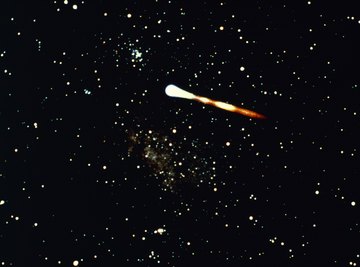
Comets are among the most fascinating of astronomical objects. Small, icy bodies that travel through the solar system on extremely elliptical orbits, comets that pass close to Earth can provide an exciting celestial display. Some comets, such as Halley’s comet, are known to return regularly, and astronomers have documented them through the centuries. Other comets appear only once and never return to the area close to the sun. You can diagram the elliptical orbit of a comet as a science project to show clearly the shape of its orbit.
- Poster board
- Pencil
- Ruler
- Two pins
- String
- Calculator
To show different orbits, move the pins of the foci closer together and farther apart. Close foci will produce nearly circular orbits, while distant foci produce more elliptical orbits.
Use your string and the sun focus pin to draw a circular orbit for the Earth within a few inches of the sun. Comment on the comet’s appearance when close to the Earth.
Use a ruler to draw a straight line across the middle of the poster board. This line serves as the major axis of your comet’s orbit.
Place two pins in the poster board at two points along the drawn axis line. Carefully measure and record the distance between the pins. These are the foci of your comet orbit. Designate one focus as the sun, while the other focus will represent empty space.
Tie the string into a loop and hook the loop over both of the pins. The loop should be small enough that it remains on the poster board when pulled in any direction.
Insert a pencil into the loop. Pull the loop as far as it will go from the pins and trace the shape around the pins on the poster board. You should get an ellipse, a shape that resembles a flattened circle.
Measure the length of the major axis. This is the length of the straight line within the ellipse shape. Divide this length by 2 to get the measurement for the ellipse's semi-major axis.
Determine your comet’s eccentricity. This is the ratio of the distance between your two foci to the length of the semi-major axis. The eccentricity should be between 0 and 1. Scientists use a comet's eccentricity to describe its orbit, with a higher number indicating a more elongated orbit. Compare your comet's eccentricity to the eccentricities of other famous comets.
Draw the comet at various points along the orbit. When far from the sun, the comet should just be a small ball. When closer to the sun, it will have a tail. The solar wind, which is made up of charged particles streaming outward from the sun, causes comet material to escape in the opposite direction, so make sure the tail always points away from the sun.
Things You'll Need
Tips
References
About the Author
Laurel Brown has several years experience as an educator and a writer. She won the 2008 Reingold Prize for writing in the history of science. Brown has a Ph.D. and Master of Arts in the history of science and Middle Eastern studies from Columbia University, as well as a Bachelor of Arts in astrophysics from Colgate University.
Photo Credits
Jupiterimages/Photos.com/Getty Images
